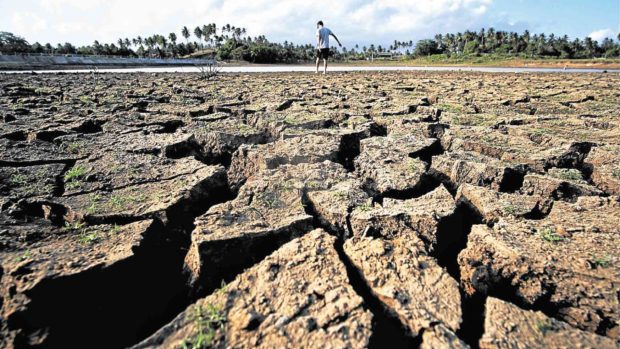
SCORCHED Extreme heat has dried up a lake in the village of Gabawan in Daraga, Albay, as the dry spell continues to ravage agricultural areas in the province. INQUIRER file photo / MARK ALVIC ESPLANA
MANILA, Philippines — The El Niño phenomenon, which would likely start to affect the country this May, has a 41 percent chance of reaching a “strong” level from November to January next year, according to the Philippine Atmospheric, Geophysical and Astronomical Services Administration (Pagasa).
Pagasa senior weather specialist Rusy Abastillas explained that although the probability for a weak to moderate El Niño in the next six months ranges from 87 to 67 percent, the agency is not ruling out the possibility that the phenomenon may intensify to a “strong” level by the end of the year.
“The chance for weak El Niño is more than 50 percent or 87 percent and 67 percent na magiging [to be] moderate,” Abastillas said in an online climate forum on Wednesday.
“But there is also a 41 percent chance na maging strong [that it will become strong] from November, December, and January,” she added.
According to Abastillas, the country is currently under El Niño Watch and will probably transition to El Niño Alert by May to July this year.
On April 18, Pagasa said that the probability of an El Niño occurrence has increased from 55 percent to 80 percent from June to September and 87 percent from November to January.
Abastillas also revealed that more dry days would occur in different parts of the country this May and October.
In May, parts of Northern Luzon, Palawan, Western, and Central Visayas may experience 21 to 25 dry days with less than one-millimeter rainfall observed, while wet days will dominate most of the country from June to July.
In October, 21 to 25 dry days will occur in parts of Luzon and Mindanao.
Aside from El Niño, Abastillos also shared weather systems such as the ridge of the high-pressure area, localized thunderstorms, easterlies, shear line, southwest monsoon “habagat,” and tropical cyclones may affect the country for the next six months.
RELATED STORIES:
Pagasa: Probability of El Niño now at least 80%
Pagasa issues El Niño Watch; urges public to prepare for warm, dry season